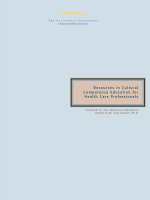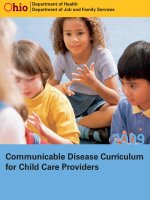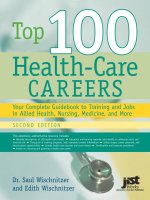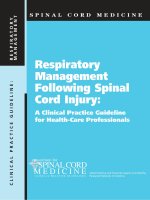Training Vaccination Training for Health Care Providers
Bạn đang xem bản rút gọn của tài liệu. Xem và tải ngay bản đầy đủ của tài liệu tại đây (2.72 MB, 62 trang )
Vaccination Training
for Health Care Providers
Agenda--1
Overview & Introductions
Flu Disease & Flu Vaccine
Intramuscular Injection
“Immunization Techniques” Video
Skills practice 1: Drawing up vaccines &
using safety syringes
Locating IM injection landmarks
Skills Practice 2: Locating IM injection
sites
Agenda--2
Skills Practice 3: FluMist administration
Giving Vaccines in a Medication Center
Adverse Reactions
Skills Practice 4: Positioning &
comforting restraint
Skills Practice 5: Locating IM injection
sites on adult and child arm and leg
Skills Practice 6: Use of Triage Algorithm
Q&A and Evaluation
What is the flu?
Highly infectious viral illness
Characterized by abrupt
onset of fever, dry cough,
muscle aches and malaise
Cough and malaise may
persist up to two weeks
Transmitted by respiratory droplets
Seasonal flu season typically
occurs late fall through spring
Flu can complicate underlying
medical conditions, causing….
Bacterial infections
Pneumonia
Sinus and ear infections
in children
Increased risk of stroke, MI, and heart
failure
Increased blood sugar in diabetics
Death
How is influenza transmitted?
Large-particle
respiratory droplets
(infected person
coughs or sneezes near
a susceptible person)
Requires close contact
(<6 feet)
Novel A H1N1 probably
spread in ways similar
to other flu viruses
Transmission of Influenza
Other possible sources of transmission:
Contact with contaminated surfaces
Via droplet nuclei--also called
“airborne” transmission (particles stay
suspended in the air)
All respiratory secretions and bodily
fluids (diarrheal stool) of novel influenza
A (H1N1) cases should be considered
potentially infectious
Distribution by Age Group of Cases
Hospitalized with Pandemic H1N1
July 2009
*April 12–June 30
Health Care Workers: Protect
Yourself, Protect Your Clients
Individuals are contagious for 1 to 4 days
before the onset of symptoms and about
5 days after the first symptom
About 50% of infected people do not
have any symptoms but are still
contagious
Health care workers are frequently the
source of influenza transmission in
health care settings
Influenza Vaccine
Why immunize?
Flu is a serious illness, the
cause of 36,000 deaths each
year in the U.S.
Immunizations are first line
of defense:
70-90% effective in <65 yrs;
30-40% in frail elderly
Immunizations prevent serious
illness, hospitalization and death
Groups at Increased Risk
for
Seasonal
Complications
Children
less thanFlu
5 years
old
Persons aged 65 years or older
People age <18 years who are on long-term aspirin
therapy (risk of Reye syndrome)
Pregnant women
Adults and children with chronic medical conditions
Adults and children who have immunosuppression
(caused by medications or by HIV)
Residents of nursing homes and other chronic-care
facilities
H1N1 vaccine—
Target groups for vaccination
All pregnant women
People who live with or care for children
age < 6 months
Healthcare and emergency services
personnel
All people ages 6 months through 24
years
Persons ages 25 through 64 years with
chronic medical conditions
Who Should Not Be
Immunized?
Anyone with:
Severe (anaphylactic) allergy
to eggs, gentamycin or a previous
dose of influenza vaccine.
Moderate to severe illness, with or
without fever
History of *GBS within 6 weeks
after a previous flu shot.
Flu Vaccine Formulations
Seasonal flu vaccine
Trivalent inactivated influenza vaccine (TIV)
Ten-dose vial
Prefilled syringe 0.25 ml and 0.5 ml
Live attenuated influenza vaccine (LAIV)
Novel H1N1 –monovalent versions of the
same formulations
Age range for vaccines and formulations
differs by manufacturer
Flu Vaccine Strains
Seasonal flu vaccine components usually
change every year
2009-10 vaccine has: A/Brisbane
(H1N1), A/Brisbane (H3N2), and
B/Brisbane
Novel H1N1 vaccine (A/California)
licensed as “change of strain”—would
have been in seasonal flu vaccine if
outbreak had started earlier in the spring
Flu Vaccine Dosage
TIV and Novel H1N1
LAIV (seasonal and novel H1N1)
0.5 ml--Children 3 years through adult
0.25 ml--Infants/toddlers age 6-35 months
0.2 ml (intranasal)
Two doses of vaccine 4 weeks apart are
needed the first year they get it for:
children under age 9 years for seasonal flu
children under age 10 years for novel H1N1
Thimerosal Free Influenza
Vaccine--1
Thimerosal is a preservative containing
ethyl mercury used in vaccines since 1930’s
No conclusive scientific evidence of harm
from exposure to thimerosal
Studies of risk were of methyl mercury
In 1999, USPHS recommended eliminating
thimerosal in vaccines for infants, as a
precaution and to retain trust in vaccine
supply
Thimerosal Free Influenza
Vaccine--2
Influenza vaccine in multi-dose vial
contains 25mcg/dose
Manufacturers make a limited amount of
thimerosal-free (<1mcg /dose) flu vaccine
Benefits of flu vaccine outweigh any
theoretical risk from thimerosal
Washington law requires that children <3
years and pregnant women be given
thimerosal-free vaccine, as of 7/1/2007
Thimerosal Free Influenza
Vaccine--3
Emergency suspension of thimerosal law
for H1N1 vaccine only, as of 9/24/09
Can give thimerosal-containing vaccine
to children <3 years and pregnant
women, BUT must give notice of the
suspension to:
Everyone < 18 years
Pregnant and breastfeeding women
10 minute break
Break out Health Educators
Use the correct needle length
for IM injections
1” minimum needle recommended
1½” to 2” needle for larger arm
Longer needles:
Hurt less
Cause fewer local reactions1
Assures proper route and a valid
dose of vaccine
Diggle L, Deeks J. BMJ 2000;321(7266):93133.









